|
How to fight IRA agony
|
 |
April 12, 2001: 6:31 a.m. ET
If you're retiring or planning to open an IRA, here's how to navigate market losses
By Staff Writer Martine Costello
|
NEW YORK (CNNfn) - Your portfolio has lost nearly half its value in the recent market downturn, so IRA season is creating a special agony for you.
If you plan to retire in 2001, you have the miserable task of dipping into a battered nest egg. If you're an existing IRA investor, you torture yourself about your losses.
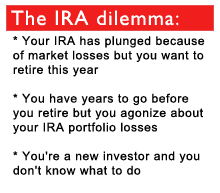 Even if you're planning to open a new IRA, you have to make choices amid a charred Wall Street landscape. Even if you're planning to open a new IRA, you have to make choices amid a charred Wall Street landscape.
"Certainly there is not a soul who hasn't been touched by this," said Bud Kasper, a certified financial planner from Kansas City, Mo.
Many people think about their IRAs around tax time because the deadline to make IRA contributions for the previous year -- in this case, 2000 -- is the same as the tax deadline. Taxes are due April 16.
All about IRAs
Good funds for your IRA
Funds wipe out tax pain
New IRA distribution rules good for heirs
New IRA rules take effect
Time to recharacterize your IRA?
The Nasdaq composite index has been flirting with a rebound, but is down 30 percent this year as of April 6 and is off 66 percent from its high reached on March 10, 2000. The Dow Jones industrial average is down 9.2 percent this year and has given up 16 percent since its Jan. 14, 2000 high. Market analysts are talking recession and wondering if Fed Chairman Alan Greenspan can come to the rescue.
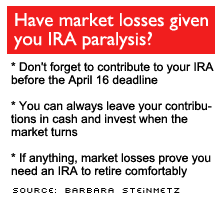 Mutual funds suffered their worst quarter since 1998 in the first three months of the year, with the average diversified stock fund down 14.65 percent as of March 29. Mutual funds suffered their worst quarter since 1998 in the first three months of the year, with the average diversified stock fund down 14.65 percent as of March 29.
"There are people right now who are postponing their retirement," Kasper said.
It's not a pretty picture, but financial planners say there are ways to minimize your IRA angst.
Retirement on half the money
Doug Flynn, a certified financial planner in New York, said the biggest mistake people make when they retire is that they need to move all of their investments into cash.
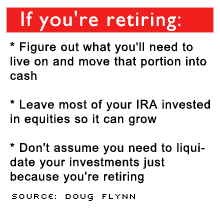 If you leave a job and want to move your 401(k) into a Rollover IRA, you should leave most of the portfolio in stocks, Flynn said. Put some of your money -- maybe 20 percent -- in bonds and cash. Then just figure out how much you need to live on every month. If you leave a job and want to move your 401(k) into a Rollover IRA, you should leave most of the portfolio in stocks, Flynn said. Put some of your money -- maybe 20 percent -- in bonds and cash. Then just figure out how much you need to live on every month.
While in many cases you can leave 401(k) money in the plan when you retire, some financial planners recommend you move your money into a Rollover IRA because chances are you'll have more investing choices and more control over distribution.
With a Rollover IRA, you can take distributions but you can still roll the money into a 401(k) if you get another job. Just make sure you don't mix that cash with any other IRAs.
You can start withdrawing from an IRA at age 59-1/2, but you'll need to take required minimum distributions at 70-1/2 with a traditional IRA. A Roth IRA has no required age for taking distributions.
Money magazine: IRA distribution rules have changed.
Keep in mind you could spend 30 years in retirement, Flynn said.
"Your IRA is 30-year money," Flynn said. "IRA money is the last money to go. It's still with you for decades and decades...Don't change your underlying investment scheme. But if you do need income, that's the issue you need to make adjustments for."
Make sure you have one to two years in cash if you're retiring now so you don't have to worry about what's happening on Wall Street, Kasper said.
Anyone whose 401(k) includes a lot of company stock has been hit particularly hard, Kasper said. A lot of companies use their stock for the portion of 401(k)s that they fund.
IRA investors with years before retirement
IRA investors with years to go before they need the money don't really need to take any action, beyond reviewing their asset allocation, Kasper said.
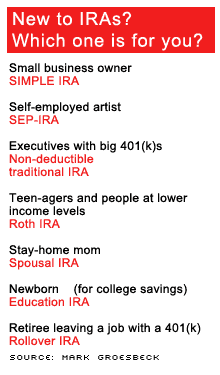 "The absolute necessity is diversity has to be in portfolios," Kasper said. That means keeping your portfolio in many different types of investments, including growth and value, large-, mid- and small-caps, as well as international stocks, bonds and cash. "The absolute necessity is diversity has to be in portfolios," Kasper said. That means keeping your portfolio in many different types of investments, including growth and value, large-, mid- and small-caps, as well as international stocks, bonds and cash.
A lot of people are suffering more now because they took too many risks during the heady days of the bull market, Kasper said. Many people made huge bets on large growth stocks and technology and are paying for it now.
"The market does function around greed and fear, and everybody was trying to squeeze out that extra 5 or 10 percent when the market soared sky high," Kasper said. "They thought they could be a little riskier. That extra risk has taken twice the toll on the downside."
Wait until the market bottoms before making any adjustments, Flynn said.
Click here for good funds for your IRA.
Still, you shouldn't make wholesale changes to your investing strategy just because the market is down now, Flynn said. Keep in mind that five, 10 or 20 years from now, the market will be higher than it is now, he said.
Only when you get within about five years from retiring and needing the money, you should start repositioning you holdings toward asset preservation, Kasper said.
Flynn suggests people use the reverse of the investing strategy known as dollar-cost averaging when they start shifting their portfolios. That means selling stocks and buying bonds a little at a time.
Getting stocks on sale
If you do feel panic seeping into your consciousness because of all of the market losses, take a hard look at the stocks in your mutual funds, said Mari Adam, a certified financial planner from Boca Raton, Fla. If you have solid, diversified mutual funds that own stocks such as General Electric (GE: Research, Estimates) and Microsoft (MSFT: Research, Estimates), you really don't need to worry, she said.
Click here for CNNfn.com's special report: Tax Time!
"Do you think GE is going to go out of business? Do you think Microsoft is going to go out of business?" Adam said. "You have to distinguish between the asset and the price of the asset."
Just because a good company like Sun Microsystems (SUNW: Research, Estimates) used to trade around $65 and now is hovering around $15 doesn't mean a lot has changed, she said.
"The bright side is you're getting good companies at a fraction of the cost," Adam said.
New to IRAs? Dive in!
New IRA investors might have the easiest job of all, financial pros say. They are starting at a time when stock valuations couldn't be more favorable.
Still, it's not always easy to figure out what type of IRA to choose from. It can be a complicated analysis deciding whether to invest in a traditional IRA or a Roth IRA. You might not know whether you can deduct the contributions or not.
A traditional, deductible IRA is for people who don't have a qualified plan at work, said Mark Groesbeck, a certified financial planner from Houston. That could be someone who works for a small company, like a flower shop or a deli, he said. You can deduct the contributions off your taxes.
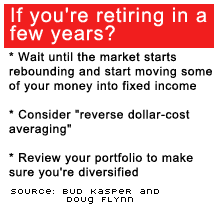 Or, if you're an executive or someone at higher income levels with a good 401(k) at work that you've maxxed out, you can choose a non-deductible, traditional IRA, he said. Or, if you're an executive or someone at higher income levels with a good 401(k) at work that you've maxxed out, you can choose a non-deductible, traditional IRA, he said.
If you're a small business owner who can't afford a retirement plan for your employees, a SIMPLE IRA might be the answer. Administrative costs are lower and employees can invest up to $6,500 a year. Employees who make less than that annually have a limit of $5,000 a year.
A self-employed artist might want to choose a SEP-IRA, which allows him to set aside up to 15 percent of his income.
Roth IRAs are a good choice for teen-agers and people who earn up to $95,000 for singles or $150,000 for couple. The contributions aren't tax-deductible but the withdrawals are tax-free.
A laid-off dot.com employee might want to switch his 401(k) money into a Rollover IRA so he can move it back into a company plan at his next job.
Need more on getting started? Money: A plan for every stage.
A lesson in stock market physics
Not too long ago, the stock market had soared so much that people started thinking the only direction was up. People assumed that just because it was on their statements, the gains were "locked in," said Flynn.
If anything, Wall Street's bloodletting is showing investors that the market moves both ways.
The Road to Riches: Build your retirement strategy.
Flynn has one client, a man in his 50s, who retired during the bull market to live in Hawaii. Now, because of stock market losses, the man has to get a job.
"He shouldn't have retired in the first place," Flynn said. "The people who got crushed shouldn't have been in the market in the first place. The money they need for the new oil burner was in the market."
The market losses also are a painful lesson that you can't depend on stock market gains to fund your retirement, said Barbara Steinmetz, a certified financial planner from Burlingame, Calif.
Investors have to do more than throw money at the hottest Internet IPO – they need to be proactive about IRA investing, Steinmetz said.
"You still have to fuel the fire through saving," Steinmetz said. "You have to keep contributing to your IRA. " 
|
|
|
|
|
 |

|

